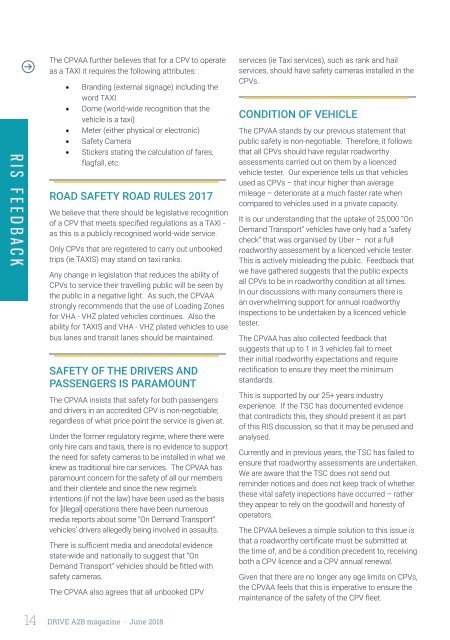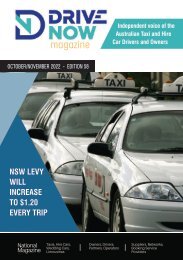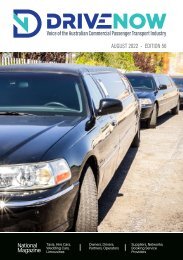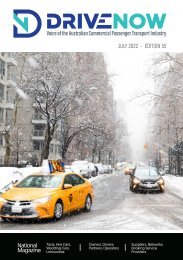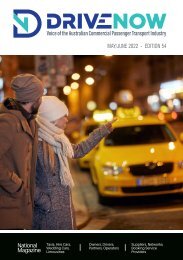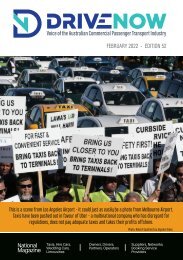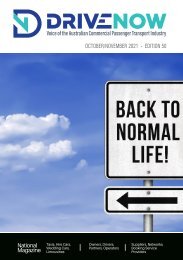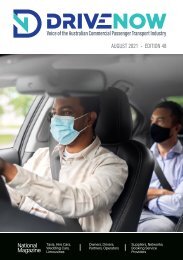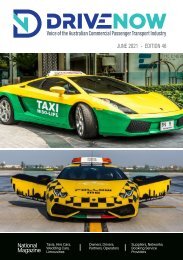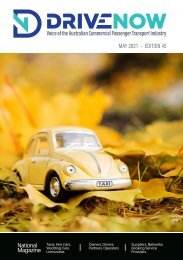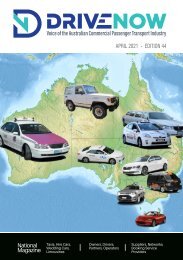DRIVE A2B June 2018
*** SCROLL DOWN TO SELECT ALTERNATIVE MAGAZINE EDITIONS *** Australia's only Magazine for the Commercial Passenger Transport Industry. News and views for Drivers, Owners and Operators of Taxi, Hire Car, Limousine, Ride Share, Booked Hire Vehicles, Rank and Hail Cars.
*** SCROLL DOWN TO SELECT ALTERNATIVE MAGAZINE EDITIONS ***
Australia's only Magazine for the Commercial Passenger Transport Industry.
News and views for Drivers, Owners and Operators of Taxi, Hire Car, Limousine, Ride Share, Booked Hire Vehicles, Rank and Hail Cars.
Create successful ePaper yourself
Turn your PDF publications into a flip-book with our unique Google optimized e-Paper software.
RIS FEEDBACK<br />
The CPVAA further believes that for a CPV to operate<br />
as a TAXI it requires the following attributes:<br />
• Branding (external signage) including the<br />
word TAXI<br />
• Dome (world-wide recognition that the<br />
vehicle is a taxi)<br />
• Meter (either physical or electronic)<br />
• Safety Camera<br />
• Stickers stating the calculation of fares,<br />
flagfall, etc.<br />
ROAD SAFETY ROAD RULES 2017<br />
We believe that there should be legislative recognition<br />
of a CPV that meets specified regulations as a TAXI -<br />
as this is a publicly recognised world-wide service.<br />
Only CPVs that are registered to carry out unbooked<br />
trips (ie TAXIS) may stand on taxi ranks.<br />
Any change in legislation that reduces the ability of<br />
CPVs to service their travelling public will be seen by<br />
the public in a negative light. As such, the CPVAA<br />
strongly recommends that the use of Loading Zones<br />
for VHA - VHZ plated vehicles continues. Also the<br />
ability for TAXIS and VHA - VHZ plated vehicles to use<br />
bus lanes and transit lanes should be maintained.<br />
SAFETY OF THE <strong>DRIVE</strong>RS AND<br />
PASSENGERS IS PARAMOUNT<br />
The CPVAA insists that safety for both passengers<br />
and drivers in an accredited CPV is non-negotiable;<br />
regardless of what price point the service is given at.<br />
Under the former regulatory regime, where there were<br />
only hire cars and taxis, there is no evidence to support<br />
the need for safety cameras to be installed in what we<br />
knew as traditional hire car services. The CPVAA has<br />
paramount concern for the safety of all our members<br />
and their clientele and since the new regime’s<br />
intentions (if not the law) have been used as the basis<br />
for [illegal] operations there have been numerous<br />
media reports about some “On Demand Transport”<br />
vehicles’ drivers allegedly being involved in assaults.<br />
There is sufficient media and anecdotal evidence<br />
state-wide and nationally to suggest that “On<br />
Demand Transport” vehicles should be fitted with<br />
safety cameras.<br />
The CPVAA also agrees that all unbooked CPV<br />
services (ie Taxi services), such as rank and hail<br />
services, should have safety cameras installed in the<br />
CPVs.<br />
CONDITION OF VEHICLE<br />
The CPVAA stands by our previous statement that<br />
public safety is non-negotiable. Therefore, it follows<br />
that all CPVs should have regular roadworthy<br />
assessments carried out on them by a licenced<br />
vehicle tester. Our experience tells us that vehicles<br />
used as CPVs – that incur higher than average<br />
mileage – deteriorate at a much faster rate when<br />
compared to vehicles used in a private capacity.<br />
It is our understanding that the uptake of 25,000 “On<br />
Demand Transport” vehicles have only had a “safety<br />
check” that was organised by Uber – not a full<br />
roadworthy assessment by a licenced vehicle tester.<br />
This is actively misleading the public. Feedback that<br />
we have gathered suggests that the public expects<br />
all CPVs to be in roadworthy condition at all times.<br />
In our discussions with many consumers there is<br />
an overwhelming support for annual roadworthy<br />
inspections to be undertaken by a licenced vehicle<br />
tester.<br />
The CPVAA has also collected feedback that<br />
suggests that up to 1 in 3 vehicles fail to meet<br />
their initial roadworthy expectations and require<br />
rectification to ensure they meet the minimum<br />
standards.<br />
This is supported by our 25+ years industry<br />
experience. If the TSC has documented evidence<br />
that contradicts this, they should present it as part<br />
of this RIS discussion, so that it may be perused and<br />
analysed.<br />
Currently and in previous years, the TSC has failed to<br />
ensure that roadworthy assessments are undertaken.<br />
We are aware that the TSC does not send out<br />
reminder notices and does not keep track of whether<br />
these vital safety inspections have occurred – rather<br />
they appear to rely on the goodwill and honesty of<br />
operators.<br />
The CPVAA believes a simple solution to this issue is<br />
that a roadworthy certificate must be submitted at<br />
the time of, and be a condition precedent to, receiving<br />
both a CPV licence and a CPV annual renewal.<br />
Given that there are no longer any age limits on CPVs,<br />
the CPVAA feels that this is imperative to ensure the<br />
maintenance of the safety of the CPV fleet.<br />
14 <strong>DRIVE</strong> <strong>A2B</strong> magazine · <strong>June</strong> <strong>2018</strong>


